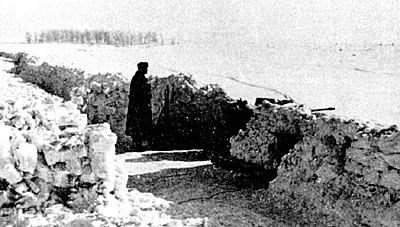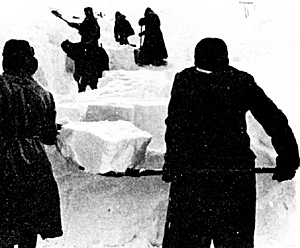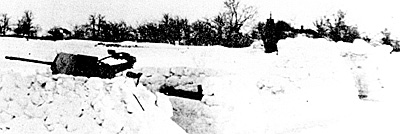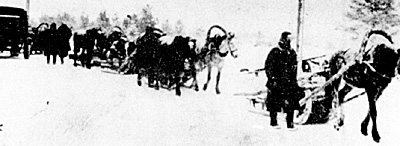 At the tactical level, German defensive practice during the winter of 1941 was dictated by Hitler's stand-fast order, the appalling weakness of German units, and the harshness of the Russian winter weather. These three factors forced the Germans to use a defensive system that consisted mostly of a network of loosely connected strongpoints backed by local reserves. This strongpoint defense had no basis in prewar German doctrine and was, in fact, wholly improvised to fit the particular circumstances existing at the time.
At the tactical level, German defensive practice during the winter of 1941 was dictated by Hitler's stand-fast order, the appalling weakness of German units, and the harshness of the Russian winter weather. These three factors forced the Germans to use a defensive system that consisted mostly of a network of loosely connected strongpoints backed by local reserves. This strongpoint defense had no basis in prewar German doctrine and was, in fact, wholly improvised to fit the particular circumstances existing at the time.
Standing fast: German infantry occupying a thin defensive line in snow trenches during the 1941-42 winter. The weapon in the revetment is a 20-mm flak gun.
As the 197th Infantry Division reported at the end of the winter fighting: "A strongpoint-style deployment can only be an emergency expedient (Notbehelf), especially against the combat methods of the Russians with their skill at penetration and infiltration. On the basis
of his previous training, the German soldier is not disposed to a strongpoint-style defense." [29]
Although some Germans later represented the strongpoint defense as being a shrewd method of slowing a superior enemy by controlling road junctions, any such success was largely coincidental. The strongpoint defense was, first and foremost, a tactic of weakness. German commanders did not elect to fight from village-based strongpoints due to any cunning assessment of Soviet vulnerabilities.
Rather, the German winter defense coagulated around towns because Hitler
forbade voluntary withdrawals, because German divisions were too weak to hold a continuous line, and lastly, because the winter weather lashed at unprotected German units that tried to stand in the open.
When the German armies on the Eastern Front began defensive operations in early December, they did not expect an immediate major Soviet counteroffensive. Therefore, most German divisions deployed into a thin linear defense similar to that used by the Army Group Center units during the August and September defensive battles. Lacking the depth and reserves of a true Elastic Defense, this linear formation merely stretched German
forward units into a semblance of a continuous defensive front. Such a tissue-thin deployment could only have served to prevent large-scale infiltration or, at the very best, to fend off local attacks.
The 31st Infantry Division, holding a broad divisional sector southwest of Moscow, "had to return more or less to the old [pre-1917] Linear Tactics, and had to foresake a defensive deployment in depth" due to lack of forces. The division's main line of resistance consisted of a "thin string of infantry sentry posts, with large uncovered areas in between" and was held together chiefly by the fire from the 31st Division's few surviving
artillery pieces. The artillery gun positions, fitted out as small infantry redoubts, provided the only defensive depth.
[30]
The Soviet counteroffensive completely overwhelmed this flimsy German
defensive line, and those German units not destroyed outright were swept rearward in a
series of running battles against superior Red Army forces. The 31st Division, its own
sector quiet until 14 December, had its front lines perforated on that date by several Soviet
attacks. When the scratch German reserves failed to restore the division's front, the 31st
Division, like most German units on the central portion of the Eastern Front, initiated a
fighting withdrawal in the hope of reestablishing a linear defense farther to the rear. [31]
Pitifully weak in men and firepower and generally inferior to the Russians in winter
cross-country mobility, the Germans found it difficult to break contact with the enemy and
to slip across the frozen landscape unmolested. German infantry companies and battalions
were so understrength that they could not be subdivided any further in order to create
rearguards. Consequently, an entire battalion (scarcely amounting to a single undermanned
rifle company in most cases) commonly had to remain in place to cover the remainder of a
regiment as it withdrew.
The outlook for these rearguards was grim: "[The rearguard carried] the large
burden of the fighting. Frequently they had to stop and delay the pursuing enemy, while
other Russian elements were already attacking their flanks or rear. Then they had to fight
their way out, or pass through the enemy lines at night to join their own forces." [32]
Needless to say, many rearguard detachments were swallowed whole by the
advancing Soviets.
Even with the occasional sacrifice of the rearguards, units clambering rearward over the snowy wastes remained extremely vulnerable to attack or
ambush by fast-moving Soviet pursuit columns. During a withdrawal, one battalion of the 289th Infantry Regiment (98th Division) was attacked by Soviet forces and nearly annihilated, losing all of its antitank weapons and machine guns. [33]
To protect itself from such peril, the 35th Infantry Division put its engineers to work blasting hasty defensive positions into the frozen ground along proposed withdrawal routes in order to provide emergency cover during retreats. However, on occasion, this action
backfired, as when Soviet cavalry and ski troops slipped into the German rear, occupied the
intermediate positions, and raked the approaching Germans with deadly small-arms fire. [34]
Seemingly beset by relentless Red Army forces from all sides, many German units
began to exhibit an acute fear of being encircled or outflanked. [35]
Soviet tanks posed the greatest threat to the retreating Germans. The Russian T-34s had excellent cross-country mobility and had little to fear from German light anti-tank
weapons. The few heavy guns that the Germans still possessed tended to wallow helplessly
in the deep snow, unable to deploy or to engage the Russian armor. [36]
German officers noted that epidemics of tank fear were again afflicting entire units, and local withdrawals sometimes turned into headlong, panic-stricken flight at the first appearance of Soviet tanks. [37]
Though kept well in hand by their own leaders, retreating soldiers of the 31st
Division passed telltale evidence of disintegration in other units: quantities of artillery,
engineering equipment, supplies, and motor vehicles all abandoned in place by fleeing
German forces. [38]
Such local incidents aroused concern not only for German morale, but also about German small-unit leadership. The wastage in combat officers and noncommissioned officers since the beginning of Barbarossa had been tremendous. By mid-December, lieutenants were commanding many German infantry battalions, while sergeants or corporals led nearly all platoons and many companies. The continued effectiveness of even these remaining leaders was suspect due to the cumulative strain of fatigue and
uninterrupted combat. [39]
The Germans first began to use strongpoint defensive positions during these hazardous early withdrawals. Frequently out of contact with neighboring forces and lacking sufficient time to prepare real defensive works, retreating units formed self-defense hedgehog perimeters like the rapidly advancing panzers had done during the previous summer.
The 31st Infantry Division, for instance, abandoned all pretense at linear defense
as soon as its own withdrawals began. [40]
Likewise, the 137th Infantry Division pinpointed its own adoption of strongpoint tactics to the beginning of difficult retrograde engagements southeast of Yukhnov. According to the division's former operations officer, from that point on "for all practical purposes the campaign consisted of a battle for villages. Positions in open terrain were seldom possible due to the weather conditions, and only then when we remained several days in one position and the engineers could aid in blasting through the meter-deep frost." [41]
Hitler's 16 December no-retreat order curtailed the flurry of piecemeal
withdrawals. By forbidding even local retreats without permission from the highest
authority, this directive forced German units into a positional defense. The strongpoint style
of defense, having come into wide use as a protective measure during the pell-mell
retrograde operations, was extended into a general defensive system across most of the
German front. Bearing little visible resemblance to the Elastic Defense postulated in prewar
manuals, the strongpoint defense therefore evolved solely in response to the peculiar conditions of the winter battles.
The second factor necessitating a strongpoint scheme was the weakness of
German units. In fact, German units stood at such low levels that no continuous front could realistically be sustained. This was true not only at the operational level where gaps between German divisions, corps, and armies had been routine since July, but even at the tactical level as well.
At the start of the Soviet drive, the "continuous" line held by Army Group Center
was, in fact, already a discontinuous series of unit fronts. Divisions of the German Fourth
Army were allotted sectors thirty to sixty kilometers wide, although most infantry
companies contained only twenty-five to forty men. [42]
Such strengths were clearly insufficient to man a solid defensive front.
Losses during the first days of the Soviet counterthrust extinguished any lingering
possibility of a continuous linear defense. In the Ninth Army's 35th Infantry Division, cold
and Soviet attacks whittled the average rifle company strength from ten noncommissioned
officers (NCOs) and sixty men on 7 December to five NCOs and twenty men just five days
later. [43]
Panzer Group 3, bearing the brunt of the Soviet counteroffensive northwest of Moscow, reported on 19 December that its XLI Corps and LVI Panzer Corps fielded only 1,821 and 900 total combatants respectively. [44]
In a desperate attempt to create greater infantry strength, officers and men from nonessential rear services
were hurried forward, as were troops from artillery and antitank batteries whose weapons had been destroyed or abandoned. Though providing some relief, the relatively small number of additional riflemen thus created had no substantial impact. [45]
Losses in weapons and equipment paralleled those in personnel. By mid December, field artillery pieces, antitank guns, motor vehicles, and tanks were all in particularly short supply. Panzer Group 4 estimated on 18 December that only 25 to 30 percent of its heavy weapons remained in action, while Panzer Group 3 counted only twenty-one artillery pieces
of 100-mm or larger still operational among its six divisions. Similarly, the LVI Panzer Corps had lost so much of its equipment that it remained a corps-size unit in name only: its four panzer divisions together mustered only thirty-four tanks, and its 6th Panzer Division
had no running tanks whatsoever. [46]
This lack of heavy weapons further diminished the Germans' ability to hold continuous positions, while the shortage of effective motorized forces foreclosed the possibility of any type of mobile defense.
This overall weakness of German units made a renewed linear defense impossible. Not only could assigned frontages not be covered, but any such
extended deployment would further disperse what few troops and weapons remained. Consequently, to prevent German combat power from evaporating altogether, German company and battalion commanders instinctively drew their beleaguered units into small strongpoint garrisons when Hitler ordered them to "fanatical resistance" in place.
The severe winter weather was the third major reason that caused German
defenders to adopt village-based strongpoints. Even by Russian standards, the 1941-42 winter was particularly harsh. From December until early March, military operations were hampered by heavy snowfall and by the few hours of winter daylight. Yet the extreme cold was by far the most significant aspect of the winter weather. During the winter battles, German and Russian forces clashed in temperatures routinely ranging from -10 degrees C to
-30 degress C, with brief cold spells exceeding -40 degrees C.
[47]
Contrary to German belief, the cold was an impartial adversary that dogged the
operations of both sides with equal intensity. However, the Germans were generally more
vulnerable to the debilitating effects of the subzero temperatures due to a near-total lack of
winter clothing and equipment.
Hitler blamed the Army High Command for the failure to provide winter
necessities, ignoring any intimation that he might bear some blame for the German military
predicament. In a clever propaganda stroke, Nazi Party functionaries launched a massive
emergency drive in late December to collect winter clothing from the German public. Direct
action by the party and the people, it was implied, would rapidly correct the scandalous
frontline conditions wrought by General Staff bungling. [48]
Coming at a time when Hitler was relieving "incompetent" and "disloyal" officers left and right, this program confirmed the popular impression that Adolf Hitler's personal intervention into the German Army's affairs was not only warranted but even overdue. So persuasive was this logic-and so thorough the propaganda effort to sell it-that even some high-ranking German military officers remained convinced after the war that slipshod General Staff planning had produced the shortage of winter equipment. [49]
However, the truth was far different. German soldiers fought without winter
clothing or special equipment simply because the German supply system could not transport
the items forward from rear depots. Normal winter-issue items (woolen vests, caps,
earmuffs, scarves, and sweaters) were stocked in Germany and Poland, and General Halder
had repeatedly discussed the need to provide these and other essentials to the fighting forces
before the onset of winter. On 10 November, however, Halder learned that transportation
difficulties would delay deliveries of winter clothing to the front until late January 1942 or
even later. [50]
The German logistical system, already tottering from the strain of providing fuel,
food, and ammunition to three army groups over the primitive Russian transportation net,
was brought to the brink of total collapse by the arrival of winter. Sporadic partisan activity
and an epidemic of locomotive breakdowns greatly curtailed German rail-haul capacity.
(For instance, the number of German supply trains to the Eastern Front totaled only 1,420
in January 1942, compared to 2,093 in September 1941.) [51]
Losses of motor vehicles and draft horses further snarled supply distribution, and
frantic attempts to press Russian pony-drawn panje wagons into service provided little
immediate relief. Moreover, the severe cold increased the consumption rate of certain
commodities. For example, German soldiers used large quantities of grenades and
explosives to fracture the frozen earth in order to create makeshift foxholes. Likewise, fuel
consumption did not decline in proportion to vehicle losses since drivers idled their motors
round-the-clock to prevent engine freeze-up. [52]
Because the supply lines could not handle all the supplies that the Germans
needed, the limited transportation space was devoted to such vital cargoes as ammunition
and medical supplies. Since winter clothing is inherently bulky and therefore relatively
inefficient to transport, it remained, for the most part, crated in warehouses in Poland and
Germany, awaiting a lull in the logistical crisis when it could be shuttled forward without
displacing other commodities. [53]
In the meantime, German soldiers had to fend for themselves as best they could. [54]
Without winter clothing to protect them against the subzero temperatures, German
units gravitated to Russian towns and villages to find shelter. This shelter was, quite
literally, essential to German survival as troops without winter clothing quickly contracted
frostbite unless treated to periodic warmups. Also, units deployed in the open overnight
courted wholesale death by freezing. Even with the Soviet winter counteroffensive in full
swing, coldweather casualties exceeded combat losses in most German units. One German
infantry regiment, heavily engaged at the beginning of the Soviet attack, estimated that its
losses in two days of fighting amounted to only 100 battle casualties compared to 800 cases
of frostbite. [55]
As the LVII Panzer Corps' war diary succinctly stated on 26 December, "The weather increasingly stands as the troops' greatest enemy." [56]
Russian villages not only offered immediate protection from the cold, but they also
provided relief from many of the collateral problems of winter warfare as well. Food could
be warmed and drinking water thawed, thereby reducing the cases of stomach dysentery that lengthened German sick lists. Wounded soldiers could receive medical care without immediate fear of death due to gangrene or exposure. Villages normally had supplies of straw, with which German soldiers could pad their boots and uniforms against the cold. Indoors, soldiers could more easily attend to personal hygiene--a matter of some consequence considering that German units reported more than 10,000 cases of typhus before spring. [57]
Finally, small arms and other items of equipment could be cleaned and warmed inside heated huts. This last task had a significance beyond normal preventive maintenance, for the extreme cold made gunmetal brittle and weapons kept outside tended to jam or malfunction due to broken bolts and firing pins. [58]
By mid to late December, much of the German defensive front in Russia consisted
of a series of local strongpoints, where battered German units defended themselves as best
they could against waves of Russian attacks.* [Hitler, with an orator's ear for colorful metaphor,
preferred the term "hedgehog" (Igelstellung) to the more bland term "strongpoint" (Stutzpunkt). By the end of the
war, many officers were emulating the Fuhrer's verbal usage, though Stutzpunkt remained the technically correct
term appearing in German doctrinal publications.]
Since the combat strength of units had wasted away to where a continuous
defensive line could not be held or even manned, and because Hitler had forbidden any
large-scale withdrawal, this strongpoint defensive system emerged as the only plausible
solution to the difficult winter situation. This system offered German forces a chance to
defend themselves in place by concentrating what few resources remained without abandoning large chunks of territory entirely to Russian control. In addition, the village-based strongpoints provided essential shelter, since the harsh winter weather posed as dangerous a threat as the enemy. [59]
When combat reports characterized a strongpoint defense as the price of standing fast under the existing battlefield conditions, Hitler quickly issued a new directive giving his own approval to this expedient technique. Dated 26 December, this secret order began by reiterating Hitler's command that no ground be relinquished voluntarily. Glossing over the problems that had forced the strongpoint system onto the German armies, the Fuhrer then emphasized the ways in which this technique could be turned against the Russians:
The defensive system must be strengthened to the utmost, especially by converting all towns and farms into strongpoints and by maximum echelonment in depth. It is the duty of every soldier, including support troops, to use every means to hold these shelters to the last. The enemy will therefore be denied use of these localities. He will thus be exposed to the freezing cold, and will be denied use of the roads for supply purposes, thereby hastening his collapse.... These principles must be fully communicated to the troops [italics in original]. [60]
German soldiers at the front scarcely needed the Fuhrer's advice on how to fight their Russian foes. The prevailing circumstances left no feasible alternative to the holding of village strongpoints. What remained to be seen was how effective this system would be in halting the Soviet counteroffensive and in saving German units from piecemeal annihilation.
 German troops digging trenches.
German troops digging trenches.
 German armored vehicles in snow revetments during December 1941.
German armored vehicles in snow revetments during December 1941.
 Horse-drawn sleds carry German supplies forward near Roslavl, December 1941.
Horse-drawn sleds carry German supplies forward near Roslavl, December 1941.
Back to Table of Contents -- Combat Studies Research # 4
Back to Combat Studies Research List of Issues
Back to MagWeb Master Magazine List
© Copyright 2005 by Coalition Web, Inc.
This article appears in MagWeb.com (Magazine Web) on the Internet World Wide Web. Other articles from military history and related magazines are available at http://www.magweb.com